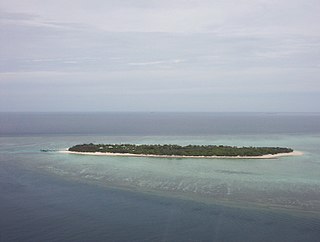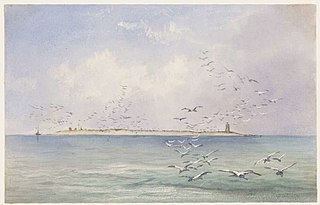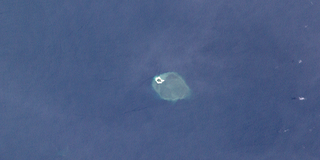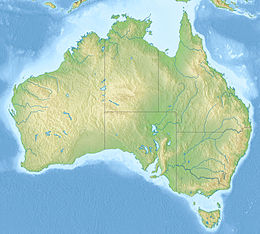
The Great Barrier Reef is the world's largest coral reef system, composed of over 2,900 individual reefs and 900 islands stretching for over 2,300 kilometres (1,400 mi) over an area of approximately 344,400 square kilometres (133,000 sq mi). The reef is located in the Coral Sea, off the coast of Queensland, Australia, separated from the coast by a channel 160 kilometres (100 mi) wide in places and over 61 metres (200 ft) deep. The Great Barrier Reef can be seen from outer space and is the world's biggest single structure made by living organisms. This reef structure is composed of and built by billions of tiny organisms, known as coral polyps. It supports a wide diversity of life and was selected as a World Heritage Site in 1981. CNN labelled it one of the Seven Natural Wonders of the World in 1997. Australian World Heritage places included it in its list in 2007. The Queensland National Trust named it a state icon of Queensland in 2006.

The Great Barrier Reef Marine Park protects a large part of Australia's Great Barrier Reef from damaging activities. It is a vast multiple-use Marine Park which supports a wide range of uses, including commercial marine tourism, fishing, ports and shipping, recreation, scientific research and Indigenous traditional use. Fishing and the removal of artefacts or wildlife is strictly regulated, and commercial shipping traffic must stick to certain specific defined shipping routes that avoid the most sensitive areas of the park. The Great Barrier Reef is the largest and best known coral reef ecosystem in the world. Its reefs, almost 3000 in total, represent about 10 per cent of all the coral reef areas in the world. It supports an amazing variety of biodiversity, providing a home to thousands of coral and other invertebrate species, bony fish, sharks, rays, marine mammals, marine turtles, sea snakes, as well as algae and other marine plants.

Capricornia Cays is both a national park and a scientific national park in Queensland (Australia), located 486 km and 472 km north of the state capital Brisbane respectively. Collectively they comprise 241 ha of coral cays.

Fitzroy Island National Park is a gazetted protected area covering Fitzroy Island, in Far North Queensland, Queensland, Australia. Fitzroy Island, is a continental island located 22 kilometres (14 mi) east of Cairns on the mainland.

Green Island National Park is a protected area declared over a small coral cay of Green Island, Cairns Region, Queensland, Australia. It is known to the local Gungganyji Aboriginal peoples as Dabuukji. The Gungganyji people used the island as an initiation ground.

Heron Island is a coral cay located near the Tropic of Capricorn in the southern Great Barrier Reef, 80 kilometres north-east of Gladstone, Queensland, Australia, and 460 km (290 mi) north-north-west of the state capital Brisbane. The island is situated on the leeward (western) side of Heron Reef, a fringing platform reef of significant biodiversity, supporting around 900 of the 1,500 fish species and 72% of the coral species found on the Great Barrier Reef. During the summer months Heron Island is also home to over 200,000 birds including Noddy Terns and Mutton Birds.

North West Island is a coral cay in the southern Great Barrier Reef, located 75 kilometres northeast of Gladstone, Queensland. North West Island forms part of Capricornia Cays National Park and with an area of 1.05 km2, the island is the second largest coral cay in the Great Barrier Reef. It is part of the Capricornia Cays Important Bird Area.

Lady Musgrave Island is a 14 hectares coral cay on Australia's Great Barrier Reef, with a 1,192 hectares surrounding reef. The island is the second southernmost island in the Great Barrier Reef chain of islands. The Island is named after Lady Lucinda Musgrave, the wife of Sir Anthony Musgrave, a colonial governor of Queensland.

The Great Barrier Reef is the world's largest reef systems, stretching along the East coast of Australia from the northern tip down at Cape York to the town of Bundaberg, is composed of roughly 2,900 individual reefs and 940 islands and cays that stretch for 2,300 kilometres (1,616 mi) and cover an area of approximately 344,400 square kilometres (133,000 sq mi). The reef is located in the Coral Sea, off the coast of Queensland in northeast Australia. A large part of the reef is protected by the Great Barrier Reef Marine Park.

Raine Island is a vegetated coral cay 32 hectares in total area situated on the outer edges of the Great Barrier Reef off northeastern Australia. It lies approximately 620 km (390 mi) north-northwest of Cairns in Queensland, about 120 kilometres (75 mi) east-northeast of Cape Grenville on the Cape York Peninsula.

The Wreck Reefs are located in the southern part of the Coral Sea Islands approximately 450 kilometres (280 mi) east-north-east of Gladstone, Queensland, Australia.

The islands and reefs of the Capricorn and Bunker Group are situated astride the Tropic of Capricorn at the southern end of the Great Barrier Reef, approximately 80 kilometres east of Gladstone, which is situated on the central coast of the Gladstone Region, Queensland, Australia.
Fairfax Islands is a pair of small coral cays, both of which have been used as a bombing range. They are located near the Tropic of Capricorn in the southern Great Barrier Reef, 113 kilometres (70 mi) due east of Gladstone, Queensland, Australia, and 405 km (252 mi) north of the state capital Brisbane.
Hoskyn Islands is a pair of small coral cays. They are located near the Tropic of Capricorn in the southern Great Barrier Reef, 107 km due east of Gladstone, Queensland, Australia, and 412 km north of the state capital Brisbane.
One Tree Island is a small coral cay. It is located near the Tropic of Capricorn in the southern Great Barrier Reef, 96 km due east nor east of Gladstone, Queensland, Australia, and 450 km north of the state capital Brisbane. The island is part of the Great Barrier Reef chain of islands, and is part of the Capricorn and Bunker Group of island and forms part of the Capricornia Cays National Park. It is also part of the Capricornia Cays Important Bird Area.
Tryon Island is a coral cay located in the southern Great Barrier Reef, 86 km northeast of Gladstone, Queensland, Australia, and 465 km north of the state capital Brisbane. The island is a protected area and forms part of Capricornia Cays National Park. It is part of the Capricornia Cays Important Bird Area. The cay covers an area of 0.21 square kilometres and is surrounded by a coral reef that is partially exposed at low-tide.

Bramble Cay, also known as Maizab Kaur and Massaramcoer, is a small cay located at the northeastern edge of Australia and the Torres Strait Islands of Queensland and at the northern end of the Great Barrier Reef. Lying around 50 km (31 mi) north of Erub Island in the Gulf of Papua, it is the northernmost point of land of Australia and marks the end of the Great Barrier Reef.

The Coral Sea Reserves Ramsar Site comprises the 17,289 km2 of oceanic island and reef habitats within the former Coringa-Herald National Nature Reserve and the former Lihou Reef National Nature Reserve in the Australian Coral Sea Islands Territory.

Lady Elliot Island Light is an active lighthouse located on Lady Elliot Island, the southernmost coral cay of the Great Barrier Reef, 46 nautical miles north-east of Bundaberg, Queensland, Australia. The lighthouse is located on the western side of the island. It was the third lighthouse erected in Queensland after its formation in 1859 and the first in Australia to be constructed of a timber frame clad with iron plates. The original lighthouse was deactivated in 1995 and the light was replaced by a modern skeletal tower standing close to the original lighthouse.

Tourism is one of the major industries in the Great Barrier Reef region. Approximately 2.19 million people visit the Great Barrier Reef each year. According to the WWF, tourism of the area contributes $5.89 billion a year to the Australian economy, and employs approximately 69,000 people. Ove Hoegh-Guldberg sees the key competitive advantage of the Great Barrier Reef as opposed to other, closer, reef tourism destinations is the region's reputation as being "the most pristine coral reef on the planet". The GBRMPA states that careful management, which includes permits for camping and all commercial marine tourism within the Great Barrier Reef Marine Park, seeks to ensure that tourists have minimal impact on the reef. However, rising incidences of widespread coral bleaching, coastal development, and tourism impacts have taken a toll the biodiversity of the reef.





















